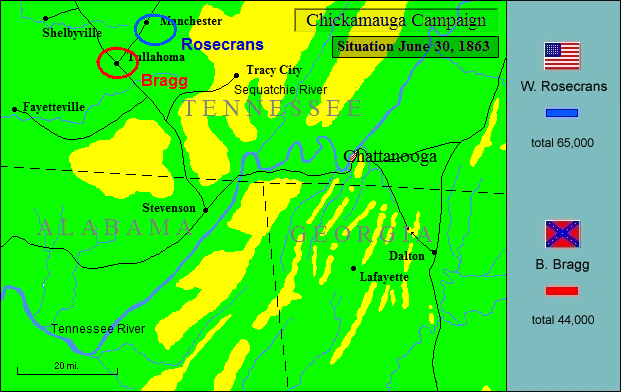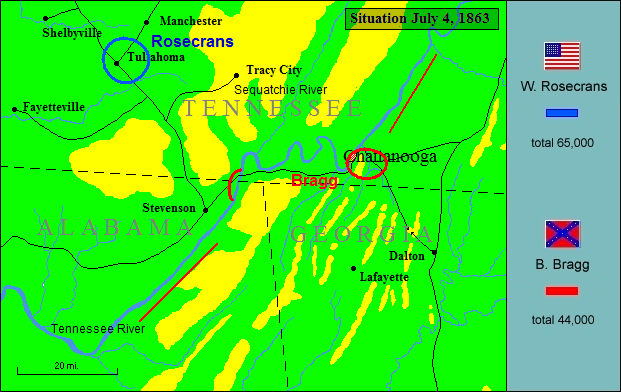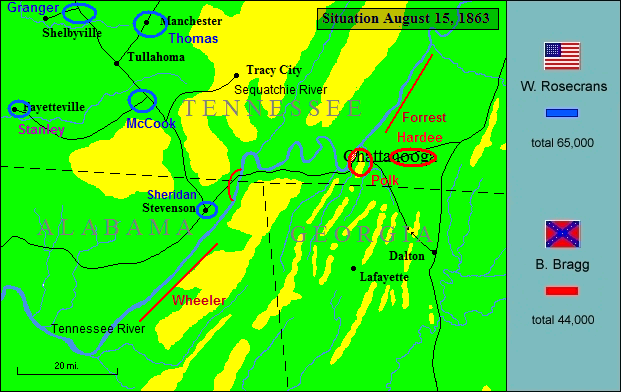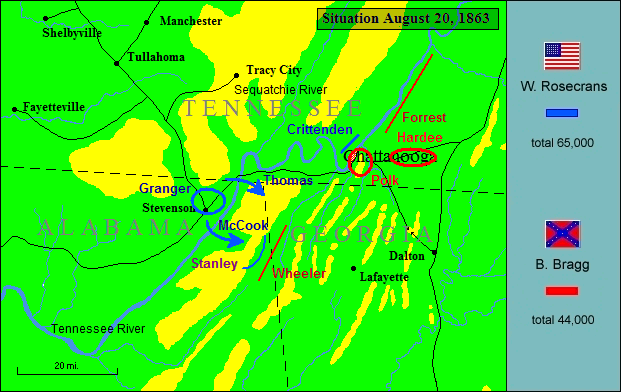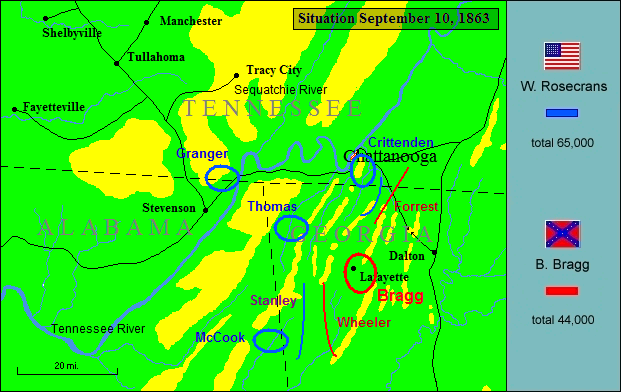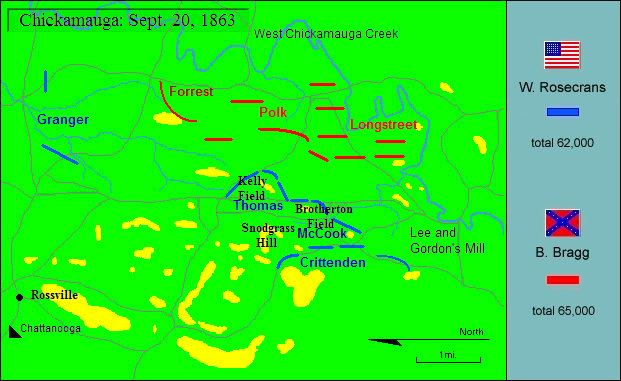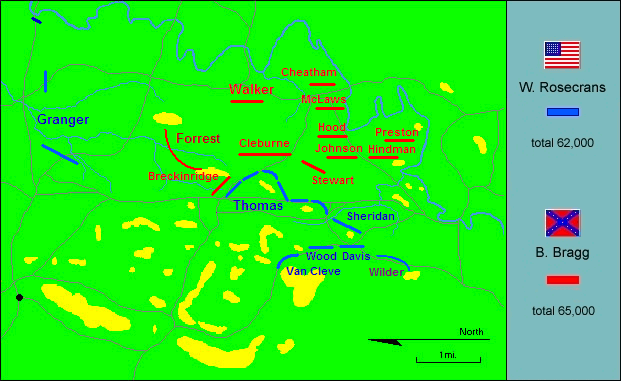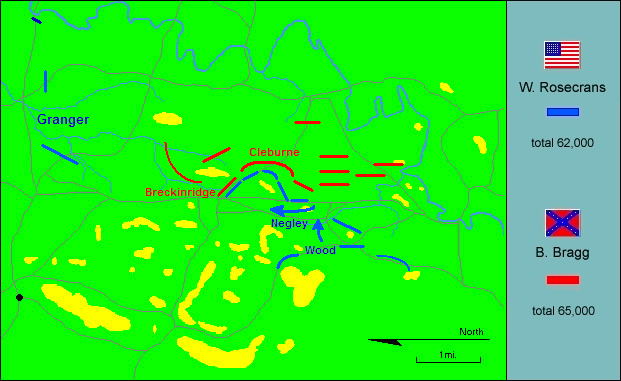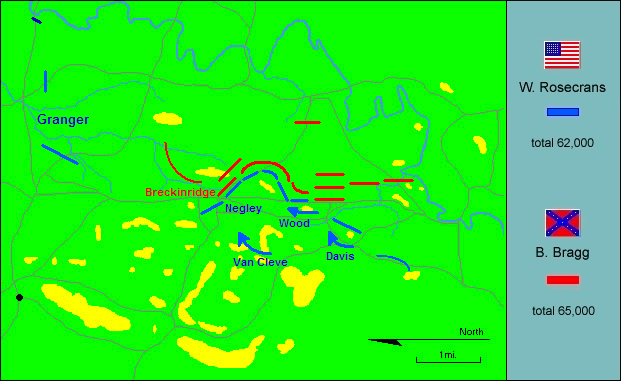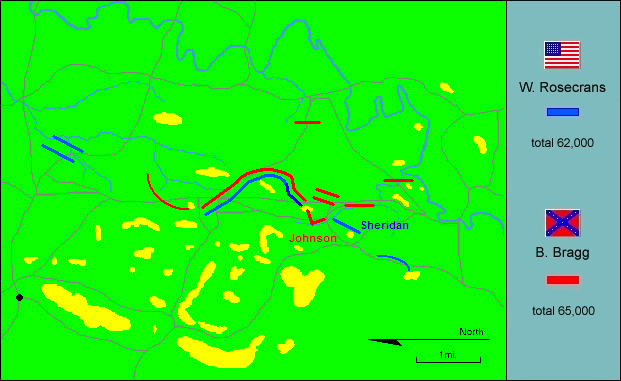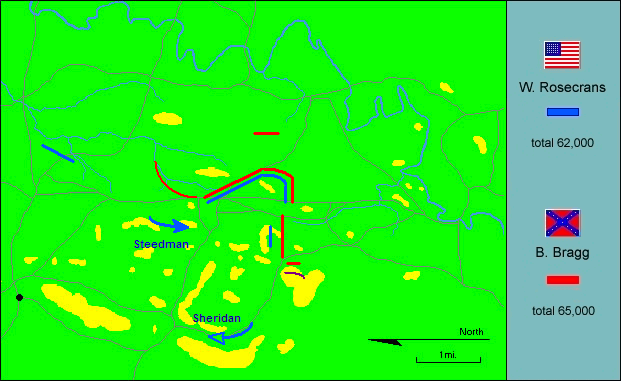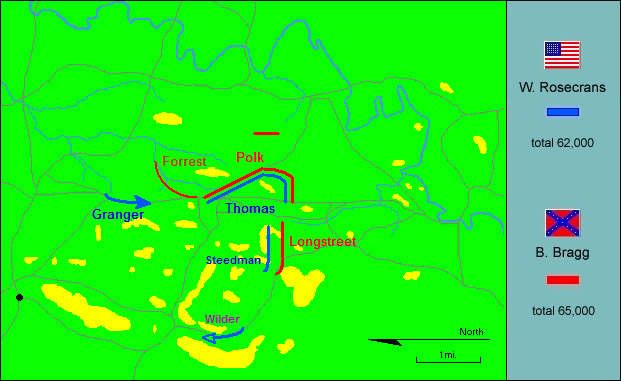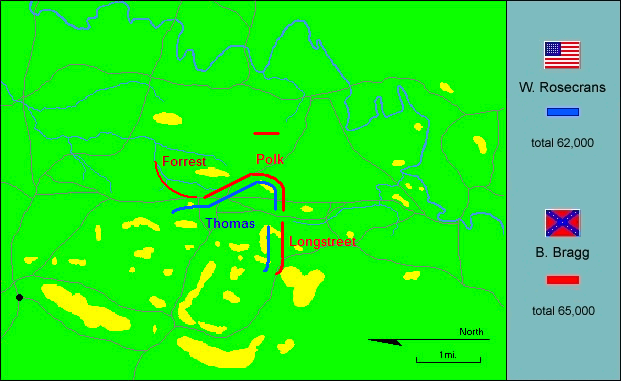This army doesn’t retreat.
–George Thomas
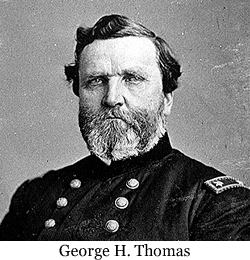
In the West it appeared that William Rosecrans, like Don Carlos Buell before him, was not going to be that man. Although repeatedly urged to action by the Lincoln government that spring, Rosecrans was still parked where he went into camp after the bloody stand-off at Stones River back at the turn of the year, in and around Murfreesboro, Tennessee. Parked likewise just down the road to Chattanooga along the Duck River was still Braxton Bragg and the Army of Tennessee. East Tennessee was something of a bugbear for Lincoln. When the rumblings of secession and disunion troubled the land back in the early spring of ’61, Lincoln had believed that, once passions had quieted a bit, a deep attachment to the Union throughout the South would prevail. He had apparently overestimated the depth of that attachment throughout the lower South, but the Unionist sentiment in east Tennessee was undeniably authentic, and Lincoln wanted the region restored to the Union once and for all. Rosecrans finally got the Army of the Cumberland in motion on June 24, and once in motion at last, he advanced with speed and skill. He had 60,000 men in four corps and another of cavalry. He made a show of swinging around the left of Bragg’s line along the Duck River, then made a hard-driving march around the right, sending each corps through a different gap of the Cumberland foothills. Despite seventeen straight days of rain, Rosecrans’ men slogged southeast fast enough to get well in Bragg’s rear before Bragg could react. With blue cavalrymen poised to cut his line to Atlanta, Bragg fell back in haste toward Chattanooga. Now Rosecrans made a show of attacking, then slipped Bragg’s flank once more. By July 4, the day Pemberton yielded Vicksburg and Lee retreated from Gettysburg, Bragg had fallen back all the way to Chattanooga itself. In a smart bit of maneuvering and hard marching, Rosecrans had drawn the Confederates 80 miles at a cost of less than 600 casualties. To Secretary of War Stanton, it seemed the moment had now come for decisive battle. To Rosecrans on July 7, he wired: “Lee’s army overthrown; Grant victorious. You and your noble army now have the chance to give the finishing blow to the rebellion. Will you neglect the chance?” This message rubbed a raw nerve in Rosecrans who wired back: “You do not appear to observe the fact that this noble army has driven the rebels from Middle Tennessee… I beg in behalf of this army that the War Department may not overlook so great an event because it is not written in letters of blood.” One wonders if Rosecrans’ complaint coupled with his pleas for reinforcements did not call to Stanton’s mind another general who wished to win victories without fighting battles–George B. McClellan. Strictly speaking, Rosecrans had maneuvered Bragg from middle Tennessee, not quite the same thing as driving him.
Nor did Rosecrans think that the moment had come to drive, though the Lincoln government urged him on repeatedly. Chattanooga was a prize whose value was hard to exaggerate. The east-west rail line that ran through the city connected what remained of the western Confederacy with Richmond; the railroad that ran southeast led through the mountains of north Georgia to Atlanta, the Gate City of the South itself. Still, Rosecrans waited, repairing the rails behind him and building a forward base of supplies. At last from General-in-Chief Henry Halleck came an explicit order: advance. On August 16 Rosecrans did so, but again not into battle but maneuver. This time he feinted a crossing of the Tennessee, then sent the bulk of his army to cross thirty miles downriver. At the same time, Ambrose Burnside’s Army of the Ohio was on the march as well, headed for Knoxville to the northeast. With Rosecrans now south of him and driving through the mountain gaps for his Western and Atlantic supply line and Burnside likewise driving toward the tiny garrison at Knoxville, Bragg decided, much to the alarm of Jefferson Davis, to abandon both Knoxville and Chattanooga and withdraw into north Georgia. On September 3, Burnside rode into Knoxville, as its garrison hurried south to join Bragg. On September 8, Rosecrans rode into Chattanooga, as Bragg and his demoralized army continued to fall back. One Rebel deserter who had enough of both war and Bragg wrote: “There is no use fighting any longer no how, for we are done gon up the Spout.”
Jefferson Davis was not quite ready to concede that the Confederacy had gone up the spout, but he did admit that this was “the darkest hour of [its] political existence.” With the Mississippi River line sundered and Lee licking his wounds on the Rappahannock, an aggressive Federal army on the road to Atlanta might well mean the end. Before Gettysburg, Lee had persuaded Davis to commit the Confederacy’s manpower and materiel in the East; now Davis would do what he could to hold on in the West. First, two divisions from Joe Johnston’s force in Mississippi went to Bragg; then, over Lee’s objections, two divisions from Longstreet’s corps with Old Pete to command went as well. (These were Hood’s and McLaws’; Pickett had not exaggerated much when he said he had no division any longer.) Leaving Richmond on September 9, Longstreet’s veterans made a journey that was persuasive testimony to Lee’s reservations about the Southern railroad system. With Knoxville gone, Longstreet’s route took him as far south as Augusta, Georgia, before he could turn west to join Bragg. Traveling 900 miles over ten different lines, only half of Longstreet’s men would be on hand for the battle now imminent. But those who were would make their weight felt.
What happened next was a series of frustrated opportunities for the Confederates, and these had everything to do with Braxton Bragg and the army shaped by two battles–Perryville and Stones River. Twice this army had gained initial success in bloody fighting only to be led away in retreat by Bragg. As a result, he continued to be deeply distrusted by his officers and despised by his men. Querulous and in ill health, he now listed boils among his other complaints. But just now he was thinking clearly about the task of turning Rosecrans back. Rosecrans, flushed with his virtually bloodless success at Chattanooga and believing Bragg in headlong retreat, came on with a rush. His three columns became widely separated in the mountainous country south of Chattanooga, and three times in four days Bragg called for attacks on the vulnerable columns. But each time the opportunity to fall on an isolated element with an overwhelming force came and went as his subordinates failed to carry through with his orders. Rancor in his official family had made this army an unresponsive instrument, and all that Bragg’s attempt to attack Rosecrans in detail achieved was to alert him to the danger and encourage him to concentrate his army with all dispatch.
By September 18 Rosecrans was pulling his columns together in the valley of West Chickamauga Creek south of Chattanooga just as the first of Longstreet’s troops–Hood’s division–were reaching Bragg. Bragg’s intention was again sound: to strike now when he had the weight of numbers and more on the way. A hard, slashing attack around Rosecrans’ left would cut him off from the railroad and Chattanooga both. The Confederate advance, however, was neither hard nor slashing, and Yankee cavalrymen with seven-shot Spencers checked it long enough for George Thomas’ corps to make a night march and come up on the left. The next morning, September 19, Rosecrans was in line parallel to the Lafayette Road and facing Chickamauga Creek to the east. Though Bragg had missed his jump yesterday, he was going to try again today, again intending to make his main effort on the Union left and turn it. A savage fight blew up in the rough, wooded country, but Bragg’s heaviest blow fell on Rosecran’s largest corps and toughest corps commander, Pap Thomas. It was a wearing all-day battle, and Bragg had little to show for it but casualties. That night Longstreet himself reached the field with two more brigades to join the fight against Rosecrans–who happened to be Old Peter’s West Point bunkmate. Longstreet now would take the left wing and Leonidas Polk the right, and in the morning they would renew the fight.
The idea on September 20 was to attack in echelon from right to left, Polk then Longstreet. The good bishop, however, was no driver and was slow getting off. (He had been responsible for one of the lost opportunities more than a week before.) Now–about 11:30–Bragg abandoned the echelon-attack and simply sent Longstreet’s veterans straight ahead to pitch into Rosecrans’ right and center. Braxton Bragg had not enjoyed much luck in a long bitter life, not indeed since that shining day in Mexico when he had ridden to the rescue of Colonel Jefferson Davis. But just now fate and a confused Federal staff officer were about to present him with one more bright moment. Across the way, Rosecrans had been capably shifting reinforcements from his right to his hard-pressed left. Through the thick woods and the fog of battle one staffer thought he saw a quarter-mile gap on the right. In fact, a division was posted there–though unseen in the woods. To plug the gap that didn’t exist, he shifted a division from the center, neatly opening a hole there for Longstreet’s veterans to go roaring through. And roar they did, breaking Yankee brigades left and right. Disaster came quickest and most completely on Rosecrans’ right which simply buckled, broke up, and went streaming off toward Chattanooga eight miles to the north. The wave of retreat carried along with it four division commanders, two corps commanders, and the army commander himself. Old Rosy’s former roommate had wrecked a third of his army.
Although Longstreet preferred to fight on the defensive, he knew a good thing when he saw it. He sent every last man of his own reserve in to exploit the breach and called on Bragg for more. Much to his disgust and dismay, Bragg refused, unwilling to seize the opportunity fate had offered. If Bragg wasn’t going to act, however, Longstreet was going to keep driving and finish off what remained of the Federal army on the left. Although most of the Federal high command were now fugitives on the way to Chattanooga, one corps commander remained on the field, George Thomas, the Virginia Union man. When the Federal right collapsed, he had swung his corps to his own right rear determined to make a fight of it. He now formed a new line on Snodgrass Hill at right angles to the Lafayette Road. Several miles to the rear was Gordon Granger’s reserve division, and at the critical moment Granger came on the run without orders, bringing fresh troops and ammunition. All afternoon Longstreet and Polk kept up a punishing pressure on Thomas’ new line, but the Yankees beat back repeated assaults until the Confederate dead, one recalled, “were piled upon each other in ricks, like cord wood.” After dark, Thomas got his fought-out men out of line and made a weary night march back to Chattanooga. He would ever after be known as the Rock of Chickamauga.
Tactically, Bragg had won a smashing success, but it was a meaningless success as long as the Federals had the prize–Chattanooga. Longstreet had learned something from Robert E. Lee about refusing to let a beaten enemy catch its breath, and he urged Bragg to strike another blow first thing in the morning, a view shared by Bedford Forrest among others. But Bragg, as at Perryville and Stones River before, was unwilling or unable to drive home initial success. With the river at Rosecrans’ back and a circle of mountains in front, Bragg reasoned, he could lay siege to the city and starve the Federals out. His subordinates, however, were convinced that Bragg was simply allowing a badly beaten enemy to escape. Longstreet was appalled. To the Richmond war department, he wrote: “nothing but the hand of God can save us or help us as long as we have our present commander.” If possible, Longstreet was even more disgusted when, a little later, Bragg, following Jefferson Davis’ advice, sent him and his two divisions on a fool’s errand to Knoxville. This effort ended in a sharp repulse on November 29 and would deny Bragg the use of 12,000 battle-toughened veterans when he most urgently needed them. For his part, Forrest was furious. To Bragg’s face, he exploded: “You have played the part of a damned scoundrel, and are a coward, and if you were any part of a man I would slap your jaws.” In fairness to Bragg, his army of nearly 60,000 had suffered 20,000 casualties in two days of bitter struggle. Among them were ten generals, including unlucky John Hood who lost a leg at Chickamauga while his mangled arm from Gettysburg was still in a sling. But Bragg in his reluctance to act decisively had unleashed another storm of rancor and recrimination within his army, a storm so intense Jefferson Davis would soon have to come west himself to resolve the strife as best he could. He did so in early October with results that could hardly have been less gratifying. All four corps commanders, in no uncertain terms and in Bragg’s presence, cast a no-confidence vote. If Bragg couldn’t command, who could? Longstreet didn’t want the job, and Davis frankly mistrusted two other possibilities, Joe Johnston and Pierre G. T. Beauregard. In the end, he sent Longstreet back east, Forrest to an independent command, and retained his old friend. The morale of the army and its officer corps had not been improved.
Abraham Lincoln was at least as dissatisfied with his commander. It was true that Old Rosy’s headquarters had been overwhelmed in the rout, but the shameful fact remained that he had quit the field when Thomas had held it. It seemed to Lincoln that Rosecrans was “confused and stunned, like a duck hit on the head.” Certainly, the predicament of his army was acute. His losses were very nearly equal to Bragg’s, and his army was for all practical purposes imprisoned in the city they had captured without a fight back on September 9. With his back against a loop of the Tennessee River, Rosecrans faced Confederates on Lookout Mountain to the south, Missionary Ridge to the east, and between him and the river to the west. More important, Confederate control of the high ground meant that the only supply route into besieged Chattanooga was a winding, vulnerable wagon road north through the rugged Cumberland Mountains. By the middle of October, it looked as if Rosecrans would be starved out of Chattanooga as surely as Pemberton had been starved out of Vicksburg. His men were cold, lousy, and gaunt. Guards had to be posted to keep men from stealing corn intended for artillery horses. Across the way, it was true, the Confederates shared their misery. The men were “sick, hollow-eyed and heart-broken,” one remembered, and when Jefferson Davis came west to confer with Bragg, he was met by cries of “Send us something to eat, Massa Jeff.” Lincoln no less urgently needed to find a way to sustain a starving army.

